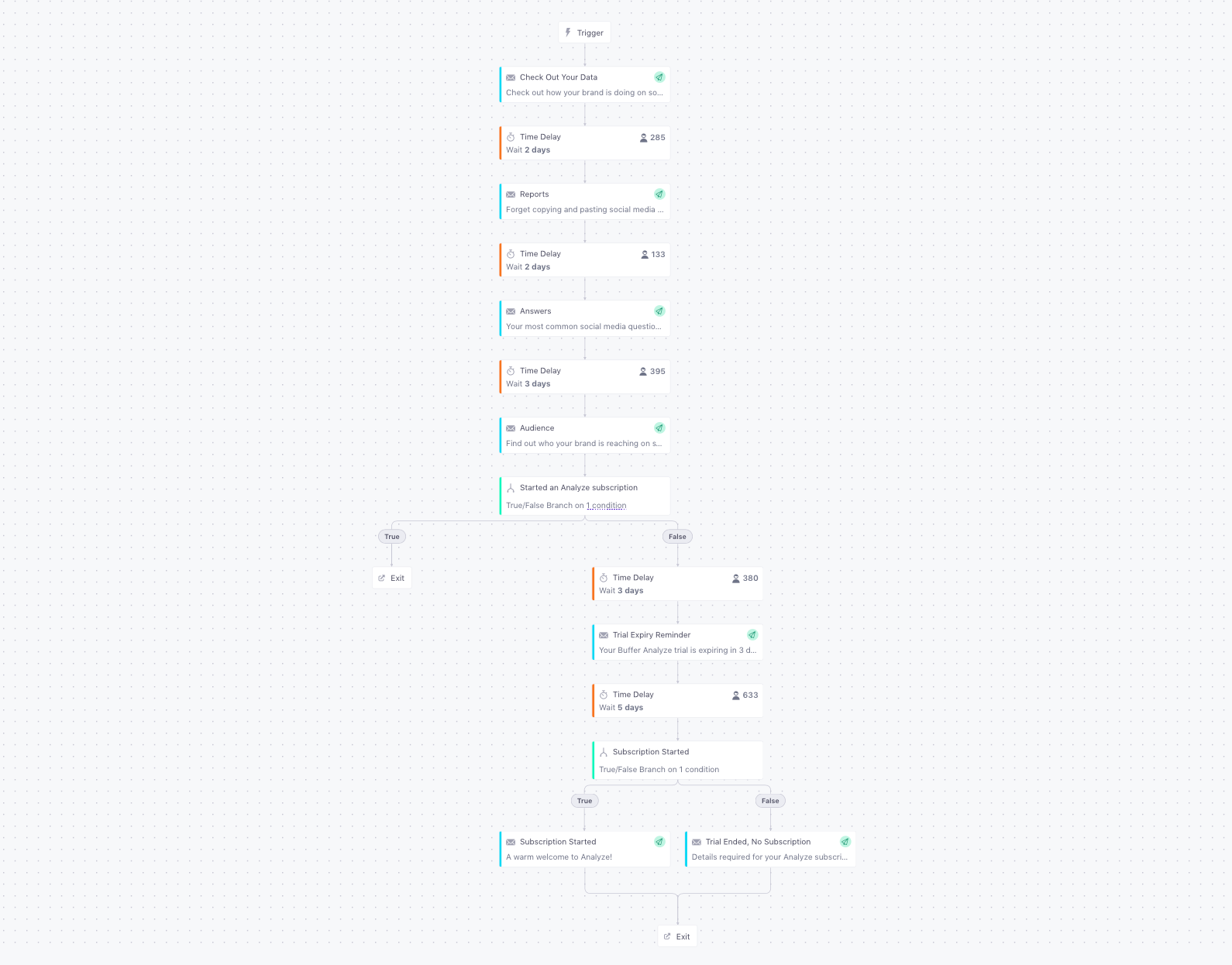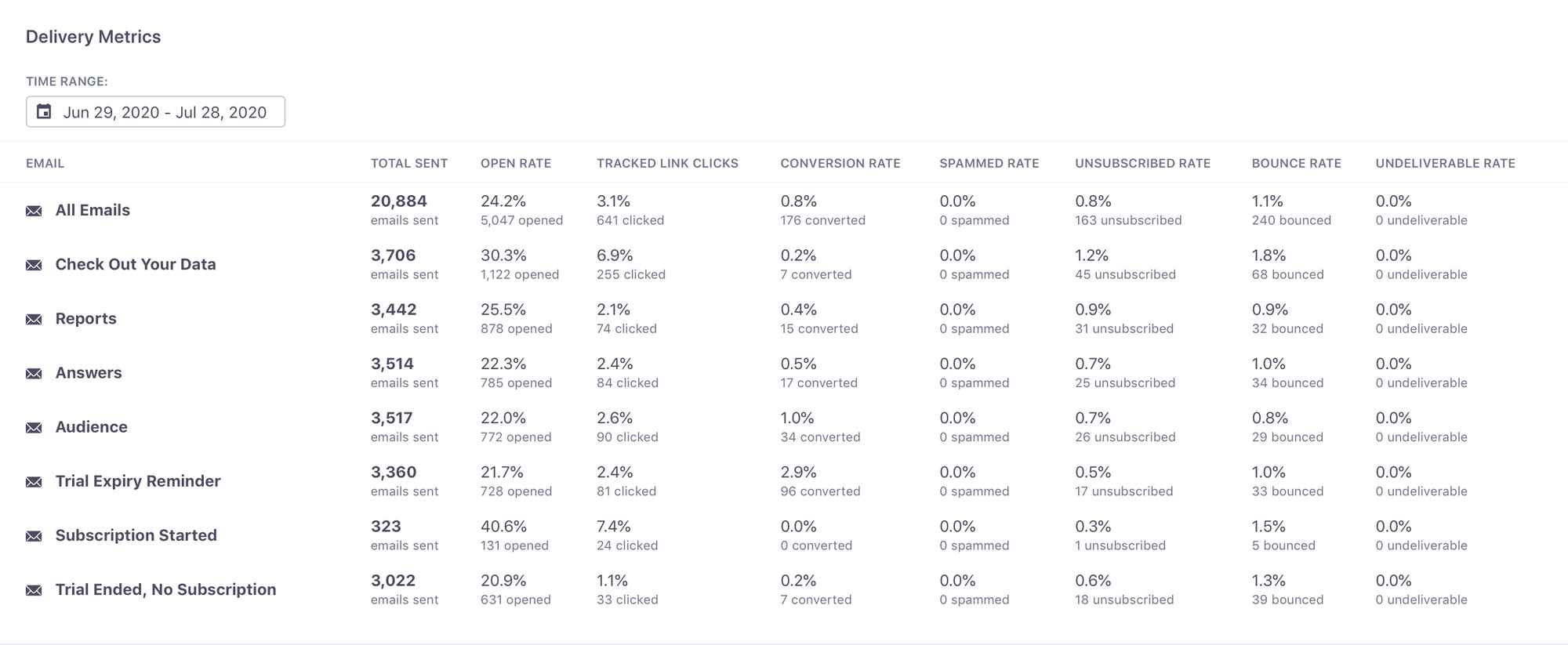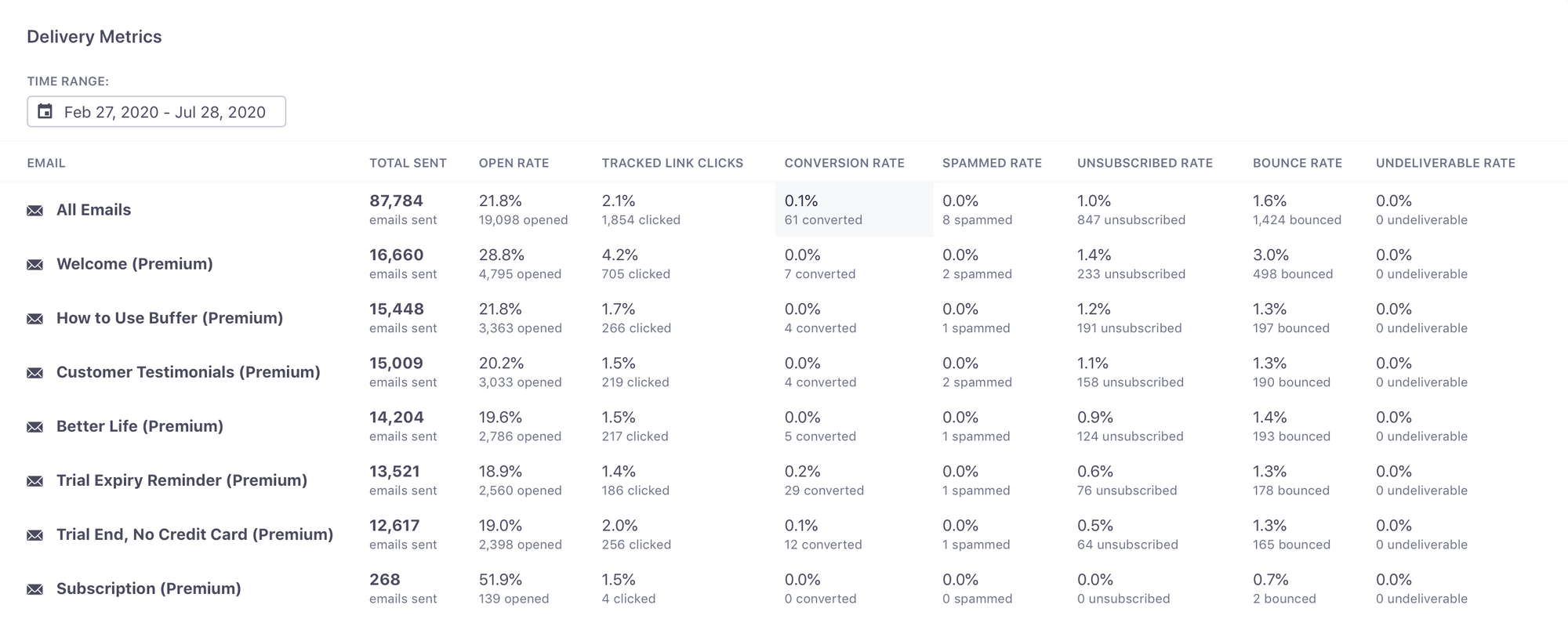Email Onboarding for SaaS
Alfred Lua / Written on 29 July 2020
Hello there,
After a few weeks of working as a product marketer and product manager, I felt the fatigue has caught up with me. My energy level was low for the whole of last week, so I took a few days off this week to recharge.
Two quick updates:
- I wrote about being more strategic with product launches and how to think about launch goals and tactics last week.
- We are hiring a VP of Product at Buffer. Our CEO, Joel Gascoigne wrote about how our product has evolved over the years and what we are looking for in the VP of Product.
Let's discuss email onboarding today.
Email onboarding at Buffer
I have had the chance to create and maintain two onboarding email campaigns at Buffer. One for our analytics product, Analyze. One for our bundle, Publish and Analyze. They are pretty straightforward at the moment. Most emails are sent with a few days gap in between, and a few are sent based on the user's actions. Nothing too complicated.
 Here's how the two onboarding campaigns have performed for the past 30 days:
Here's how the two onboarding campaigns have performed for the past 30 days:
 Analyze onboarding email stats
Analyze onboarding email stats Bundle onboarding email stats
I'm sure they can be improved, and I'm currently working to update the bundle onboarding email campaign. While I'm thinking about onboarding emails, I wanted to share a few opinions on email onboarding from my experience so far. I wouldn't say I have a ton of experience in this area but I'm quite familiar with onboarding at Buffer. So my opinions are based on that. It'll be great to hear what you think of them.
Bundle onboarding email stats
I'm sure they can be improved, and I'm currently working to update the bundle onboarding email campaign. While I'm thinking about onboarding emails, I wanted to share a few opinions on email onboarding from my experience so far. I wouldn't say I have a ton of experience in this area but I'm quite familiar with onboarding at Buffer. So my opinions are based on that. It'll be great to hear what you think of them.
1. Complement, not repeat
If you have in-app onboarding via custom-built flows, tooltips, or checklists, your email onboarding should complement, not repeat, them.
They serve different jobs and have different contexts. For in-app onboarding, users have just signed up for your product and are in your product. You should guide them to do one or a handful of things that will help them understand the value of your product as soon as possible. For email onboarding, they are in their inbox, probably not wanting to use your product at that moment (or they will be in your product). You should use the emails to achieve other things. I prefer to highlight more advanced features that are hard to understand right away or explained with a few words within the product. I also like to show social proof, such as customer testimonial or case studies, to convince users they are making the right decision to use our product. Finally, I also think it is wise to educate users with guides and tips that are relevant to your product.
Many onboarding emails consistently nudge users to take certain actions in the product if they have not done so. For example, if you have not scheduled a post in Buffer, I'd keep emailing you to schedule one. The idea is that scheduling a post in Buffer will lead users to the "Aha!" moment, which means they are more likely to convert into a customer. I do not quite agree with this. The best place and time to do that is in your product when users first sign up. In other words, via your in-app onboarding. That is when they have the highest motivation to try your product. If they did not take those actions then, would sending them multiple emails about those actions make them want to do those things? I think not. If someone signs up for Buffer, known for social media scheduling, but don't schedule a post after being prompted, more emails to remind them to schedule won't be effective. I would prefer to tell them other things that might convince them to use our product, such as analytics.
The open rates of onboarding emails will usually fall throughout the campaign, as can be seen from the stats above. The first email will have the highest open rate because it is usually sent close to the signup time when the user is most excited or curious about your product. The remaining few emails will have lower open rates because of a few reasons: the user is less interested after trying your product, the user has many more emails, likely more urgent ones, in her inbox, or the user doesn't find the emails helpful. An exception I have been seeing is the email confirming the user's subscription to our product. Because they have started to pay for the product, the motivation to open that email is much higher. All that to say you should put the most important ideas at the start of your email onboarding campaign, especially the first email.
2. Update regularly, strategically
If your product team is regularly shipping new features to your product, you should be updating your onboarding emails regularly.
You want to include any new major features that have become the most important part of your product. For example, we recently rolled out a feature to let customers plan and report their multi-channel social media campaigns. This is now one of the most important features in our product, and I'll be adding it to our onboarding emails soon. Another important reason to be updating your onboarding emails is if you are shifting the positioning of your product or company. You would want to update the copy accordingly. Finally, if you use product screenshots in your onboarding emails and your user interface has changed, you should keep them updated.
How often should you be updating your onboarding emails? It depends on how often your product team is shipping new, major features. For most startups, my hunch is going through your onboarding emails to check if they need updating every three to six months is sufficient. Updating onboarding emails can sometimes be quite a big project. so you likely can't do it more frequently if you also have other projects to do. You should be updating your onboarding emails at least once a year. Otherwise, that means your product team has not shipped anything significant for an entire year. Then the more important discussion to be had is how is your product doing, not your onboarding emails. Product marketing cannot work in isolation from the product team.
3. Don't over-optimize
It is good to keep refining your onboarding emails, especially to include new features and remove less useful features. But unless your full-time job is email onboarding, I don't think you should spend too much time optimizing the emails—at least from my experience.
Why? It's really hard to accurately measure the impact of tiny changes to your onboarding email campaign on the conversions to a paying subscription. First, you would need to implement in-house tracking or use expensive data tools to track conversion rates. Then, you would also need a tool for A/B testing emails. Even then, email tools such as Customer.io and Intercom only allow you to A/B test individual messages and not the entire campaign altogether. Having higher open and click rates for individual emails do not necessarily mean a higher conversion rate to a paying subscription. Finally, you also need to measure if any lift is statistically significant.
I'm personally not convinced micro-optimizations of onboarding emails can have a meaningful impact on conversions and revenue. Yes, some optimizations are necessary but not micro-optimizations. I believe it is better to spend time on other things than to spend too much time optimizing onboarding emails. But I could be wrong since I only have my experience at Buffer to back my claim. If you think otherwise, I'd love to learn from you.
Working with product
Even though I, as a product marketer, should promote the importance of onboarding emails, the ideal situation for me is that the product is so well-designed that onboarding emails are unnecessary. That, however, isn't the reality for most products. Onboarding emails, along with in-app messages, can be a good way to fill the gap and teach users how to use the product, especially advanced features.
If it's possible, I would prefer to work with our product team to improve the onboarding within the product because I think that's the better place and time (when users just signup) to educate the users about the product.